LOS
ANGELES TO FLORIDA VIA PHILLY
By
Jack M. Turner
The
following report details a 2002 cross country trip that can not be
duplicated
in 2008 since Amtrak cut direct Chicago to Philadelphia service. The Southwest Chief route remains one of
Amtrak's best lines and the Florida trains soldier on as popular means
of
travel in the east.
Having
lost our planned round trip to San Diego due to the late arrival of the
Sunset
Limited into
Los Angeles, we opted for a stroll to the Mexican markets on
Olvera Street. Unfortunately, our
luggage had to be towed along as a national security alert nixed the
idea of
short term bag checking. Tired
from the luggage handling, we took advantage of the red cap service
which
delivered our luggage and us directly to our sleeper via a large golf
cart. This was surely one of the
wiser moves of the trip as we avoided the long walk through the tunnel
under
the tracks as well as the steep ramp to the platform.
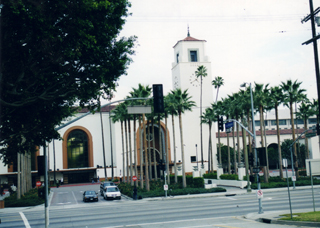 Los
Angeles Union Station, a notable landmark shown on many television
shows and
Hollywood movies
|
Santa
Fe Railway's Super Chief was known by many as The
Train of the Stars prior to Amtrak's
formation and today's Southwest Chief proudly lives up to its
heritage. We were delighted to
find our sleeper was a Superliner II car, the Illinois, which marked my
tenth state named sleeper ridden.
The red cap service got us trainside at 6pm, in advance of our
fellow
passengers. After stowing luggage
in the lower level luggage rack and in our room, again # 3, there was
ample
time to walk the platform and record car numbers. During
this trek I met Bob Stone, our crew chief and
undoubtedly one of Amtrak's finest employees. Back
in 1983 my wife Christine and I had the pleasure of
riding with Bob when he was the chief on the Sunset Limited between LA and
New Orleans. In an amazing
coincidence, I discovered Bob's excellent Southwest Chief website
(www.crewten.com) via TrainWeb.com a couple weeks before our trip,
exchanged
e-mails, and discovered he would be working on this journey. Incredibly, our meeting 19 years
earlier was one of only three times he ever worked the Sunset.
As
advertised,
the Southwest Chief pulled away from the platform
at 6:45pm though we then
had to back onto the adjacent track to couple up a pair of refrigerated
express
cars and 15 roadrailers behind our half dozen standard express cars. Before this manuever commenced, Bob
Stone had welcomed guests on board and explained the procedure rather
than
leaving novices to speculate.
Meanwhile, our car attendant Carol, another veteran of many
years with
Amtrak, followed with information pertinent to guests in the Illinois. By
7:05pm we were truly underway;
indeed this coupling procedure is run like a well oiled machine.
As
we passed the lighted Amtrak shops, we soared into the LA skies like a
majestic
jetliner taking flight as we negotiated the new Redondo Flyover. The flyover gently carried our
streamliner aloft, above other rail lines, and banked us to the east
like a
plane on takeoff. Thinking back to
the days when I enjoyed flying aboard Eastern Air Lines, I could only
hope that
Amtrak does not ever face the same bankruptcy fate.
First
call to dinner was made just 40 minutes out of the City of Angels and
once
again our sleeper was right next to the dining car.
An air of ambiance filled the diner as soft jazz played
songs like "Take the A Train" in the background as if in a
fine restaurant. Each table included a
vase containing
pink carnations. A classy menu
featuring the Southwest Chief name, a southwest style
border, and a picture of the
Grand Canyon on a blue background enhanced the dining experience. The dinner selections included The
Hawkeye (a
rib eye steak), Calvados Pork Chop, Roasted Half Chicken Veronique,
Baked Turbot, and Heartland Vegetarian Lasagna. A
choice of six desserts included Grandma's Peach Cobbler,
Margarita Cheesecake, and Chocolate Treasure. The
entrees and desserts lived up to their fanciful names as
each meal throughout the trip was presented in eye pleasing fashion by
our chef
who obviously took great pride in her work. In
fact, meals aboard the Southwest Chief would prove to be
the most enjoyable of any Amtrak trip I have ever taken.
Following
stops in Fullerton, where the San Diego line diverges, and in San
Bernandino,
train # 4 began the twisting assault on Cajon Pass along the San
Andreas
Fault. Though this trip was in
darkness, I could visualize each turn having traversed the line in
daylight
when the Desert Wind used to run as well as having
railfanned trackside a
few years ago, an experience I shall never forget.
After viewing the large BNSF yards at Barstow shortly after
11pm, I needed to turn in for the night as we crossed the Mojave Desert
and
began the process of having to set our watches forward as we crossed
time zones.
The
smooth Santa Fe tradition continues today under BNSF management,
providing an
excellent night's sleep. Following
breakfast we adjourned to the sightseer lounge to enjoy the interesting
commentary of Gerald Pinto, a member of the Navajo nation, who
explained native
lore and pointed out scenic highlights between Gallup, NM and
Albuquerque. During these three hours we
learned a
great deal about the Native American culture and the New Mexico vistas
we were
enjoying from the lounge car's oversized windows.
The
desert scenery on the Southwest Chief is spectacular as the railway
passes
numerous mesas, buttes, and red sandstone formations; offers views of
volcanic
mountains such as snow capped 11,301 ft. Mt. Taylor; traverses regions
of lava
beds; and ducks through several indian reservations.
The Continental Divide was crossed at 10:15am when we
reached 7,200 ft. at Campbell Pass.
Almost an hour later we noted the frozen Rio San Jose with
patches of
snow still visible in shaded spots.
We
reached Albuquerque at 12:10pm which allowed 45 minutes to walk the
length of
our 4 engine, 31 car train and purchase crafts from Native Americans
who carry
on a 100 year old tradition of selling wares on the platform. During the stopover, a crew washed the
sleeping cars' windows with brushes mounted on long poles which is
something
seldom seen today. As we departed
Albuquerque, lunch beckoned and we found that the menu featured five
choices
including the delicious Philly Cheesesteak sandwich that I selected.
Old
Santa Fe signs erected years ago to inform passengers of interesting
sights
remained beside the tracks at San Felipe and Santo Domingo pueblos. Departing Lamy at 2:01pm, we were
escorted by Bob Stone to the crew sleeper for a unique and excellent
view of a
famous and exceptionally scenic stretch of our route.
As good fortune had it, there was no transition crew sleeper
on this trip (it was still sitting in Albuquerque where it was bad
ordered the
previous trip). In place of the
transition car was a regular Superliner sleeper which offered a clear
forward
view over the top of the baggage car as both end doors on Superliner
sleepers
are on the upper level. Transition
sleepers have only a lower level door on the forward end to allow crew
access
to the baggage car. Thus, only on
rare occasions such as this would a forward view be possible. The forward visibility was like riding
in a dome car though it required standing up. Normally
the crew sleeper would be off limits to Amtrak
guests, however, this opportunity was granted to allow this writer to chronicle this
historic rail line.
Six
minutes past Lamy, the Southwest Chief passed through Apache Canyon
whose
narrow granite walls tightly envelope the railway.
After passing through Canoncito, the Chief tackled
impressive Glorieta Pass at 2:25pm then met the westbound Southwest
Chief at Fox
siding at
2:36. Another interesting sight,
Starvation Peak, came into view at 2:53pm, however, we would not make
our
closest pass of the distinctively shaped mountain for another 27
minutes. Before then, we crossed the Pecos
River
at Rybera and circumnavigated a famous double "S" curve 10 minutes
later at
3:15pm. Between the double "S"
curve and our next stop, Las Vegas, NM, we passed 22 classic semaphore
signals,
half of which guarded eastbound movements. The
sight of the blades lowering after our lead engines
passed was a special memory to file in our memory banks.
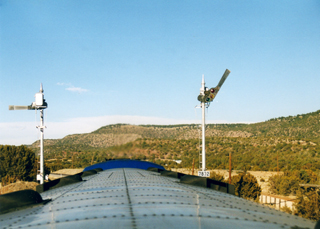 Semaphore
signals are visible on either side of Las Vegas, NM
|
Seventeen
minutes beyond Las Vegas, the Chief traversed scenic Shoemaker
Canyon
where a few more semaphores still protect train moves.
A half hour later Wagon Mound Mountain,
shaped like a prairie wagon from pioneer days, appeared dead ahead. The beauty of this region typifies the
settings of many movie westerns and, at the same time, provides
appreciation
for those who traveled the old Santa Fe trail.
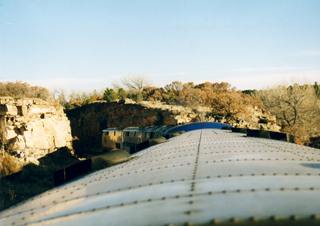 Shoemaker Canyon envelopes the train |
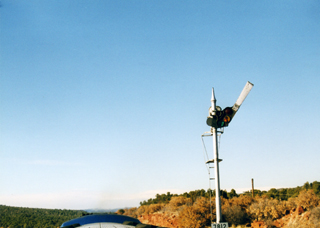 A
close up view of another semaphore
|
We
returned to our forward perch an hour later as we departed Raton, NM at
5:36pm
and began our final approach to Raton Pass, the highest point on our
line. The quartet of P42 engines were
working
hard though the westbound trek over the pass is more taxing due to a
steeper
grade. Fifteen minutes later, a
herd of 30 or 40 elk bounded down a hill and safely crossed just ahead
of our
train moments before we ducked into 1/2 mile long Raton Tunnel. Only the engineers could have witnessed
this sight like we did. When we
exited the tunnel we were in Colorado and beginning the steep downhill
journey,
passing legendary Wooten Ranch on the left. By
this time darkness had set in as building snow clouds
obscured the setting sun. If
rumors are to be believed, the sun may be setting on the Raton Pass
line as
most BNSF freight traffic uses a lower grade route through Amarillo, TX
and talk
of a sale to a short line or outright abandonment has resumed as it has
been
the case periodically in recent years.
Dinnertime
came at 6:30pm as we arrived in Trinidad, CO and once again the soft
music,
carnations, and superb cuisine made for a memorable experience. Pleasant company was enjoyed during the
meal and once more our tablemates were making their first trip by train. As John slept, we crossed into Kansas,
his 49th state, which tied him with good 'ole dad (in late 2005
we visited
Hawaii, our 50th state visited).
Passenger trains are the reason for our being able to reach so
many
states as only South Dakota has not involved any train riding. One can only hope future generations
will be able to see our great nation as well as we have.
The
morning of Friday Feb.15th found us backing into a siding at DeSoto, KS
to
uncouple several of our roadrailers which would then be driven to their
destinations. This isolated
location apparently allows train # 4 to switch out these cars without
interrupting the busy BNSF line.
During the middle of the night we had passed through Topeka and
Lawrence
on one of the few Amtrak segments I had not covered prior to this trip. On my 1976 westbound journey on the Southwest
Limited, Amtak
bypassed those cities.
After an hour spent cutting the roadrailers, we were underway
toward our
next station stop, Kansas City, MO.
Departure
from K.C. came at 8:48am, a mere 27 minutes late and shortly we climbed
over a
new flyover that has helped alleviate rail congestion at a busy rail
junction. A half hour later we
crossed the Missouri River on an impressive low steel trestle and
travelled
though rural country to LaPlata, MO.
The Chief nicks the southeastern edge of
Iowa, and we made our
sole Hawkeye State stop in Fort Madison at 12:28pm.
The Mississippi River flowed past on our right side and was
crossed just east of the station on a curved combination highway/rail
bridge. Forty minutes later we
reached Cameron Jct., where a new connector track was built through a
cornfield
a few years ago to link the former Santa Fe and Burlington lines
following the
BNSF merger. This connector is
viewed better from the Southwest Chief than the California Zephyr
as the old
ATSF
passes above the ex-CB&Q then the new connector track makes a
sweeping arc
back to the former Burlington line.
The CZ cruises at speed below the
ex-ATSF while the Chief navigates around
the connector after passing above the CB&Q. Prior
to the connector's opening, the Southwest Chief operated via
Streator and Joliet rather than Mendota and Naperville.
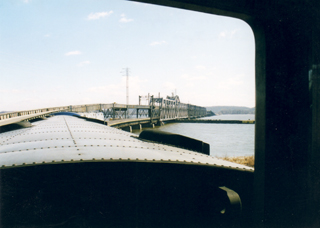 An
impressive rail/highway bridge spans the Mississippi River at Ft.
Madison, IA
|
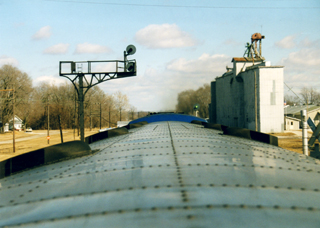 Grain
elevators line the railway in western Illinois
|
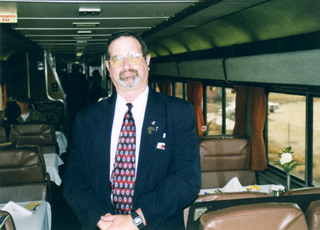 Crew
chief Bob Stone, a Dennis Miller lookalike, is one of Amtrak's finest
|
A
few minutes past Cameron Jct. we eased to a stop in Galesburg, IL which
has the
distinction of being served by three different Amtrak trains bound for
three
different destinations on their westbound journeys. By
3:13pm we were passing through Aurora and gliding along
the busy freight and commuter line through Naperville and Downers Grove. Shortly, Sears Tower and the Chicago
skyline came into view and train # 4 paused to drop its express cars
near the
Amtrak yard before backing into Union Station. Our
4:21pm arrival was actually 15 minutes ahead of schedule
and we sadly bade farewell to a train that lived up to the old Super
Chief name. The entire experience of riding the Southwest
Chief, from
scenery to ambiance, to cuisine, and crew friendliness, definitely rated
a "top ten" ranking on my list of best train rides.
Our
timely arrival gave us a five hour layover so we checked in the
Metropolitan
Lounge, stowed luggage in the check room, and decided to cover the
Orland Park
METRA line that we had yet to ride.
Train # 15 was crowded for its 5:30pm departure but we found
seats near
the middle of the long train. Part
of this line is now used by the Cardinal which makes a circuitous entry
into
the Windy City, however, we were unable to spot the point where its
route
diverges as darkness set in soon after we left Union Station. As a result, our 75 minute ride served
primarily to add another rail line to our mileage map rather than a
sightseeing
junket. Due to limited service on
this line, roundtrips are only possible on early weekday mornings and
weekday
evenings. We were able to stay on
board at Orland Park as there was a mere 10 minute layover
and at 7:51pm we were back at Union
Station and ready for a fast food dinner.
Next
up was a ride on Amtrak's Three Rivers, the successor to the famed Broadway
Limited. Our 15 minute
late departure at 9:35pm was followed by a 73 minute stop at the Amtrak
yards
to attach 1 express car and 15 roadrailers. The
delay gave me a chance to visit the Horizon cafe next
door and select a bedtime snack to supplement the McBurger from earlier. Meals, snacks, and beverages are
complimentary for sleeper passengers in an operation that is very
similar to
the Twilight Shoreliner which we reported on last fall. Prior to the trip, this food service
promised to be a letdown from the full meals enjoyed on other long
distance
trains, however, the change of pace proved quite satisfactory thanks in
part to
a most pleasant cafe attendant.
While
the train was standing still we had our attentive car attendant Dara
Lee make
up the beds. After 7 nights in
standard bedrooms, Deluxe Bedroom "A" seemed like a palace. I also was happy to add a
new Viewliner car, Tranquil View, to my list of
sleeper rides. I decided to try
out the shower in our room's bathroom and was surprised by how well it
drained;
in fact, by morning the bathroom was quite dry.
This
night's sleep was not as sound as prior nights as our room was directly
over
the wheels which produced a few sleep shattering jolts.
It also is a bit disorienting to sleep
at a right angle to the window after nights of sleeping parallel to it. Nevertheless we were ready to face the
day as train # 40 pulled out of Pittsburgh at 8:54am.
The former Pennsylvania Railroad mainline passes through
terrific mountain scenery as it works its way along the Juniata River. The eastbound run is best as it is all
in daylight. Naturally, the day's
big highlight would be Horseshoe Curve and we were primed for viewing
until a
paralleling eastbound Norfolk Southern coal train came into view on the
inside
track, obscuring the vista.
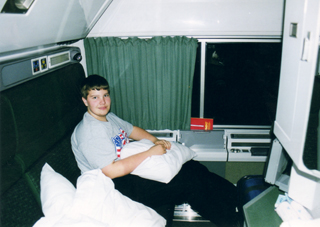 The
author's son John enjoys the spacious deluxe bedroom on the Three
Rivers
|
Several
Amish families detrained in Lancaster and soon we passed numerous Amish
farms,
recognizable by the lack of electric wires running into the homes and
by the
clothes hung out to dry in the back yards. In
the heart of this region we zipped by Leeman Place, the
junction with the Strasburg Railroad's tourist line.
As we approached Philadelphia, passing commuter stations
became more frequent though traffic was light due to it being a
Saturday. Philadelphia 30th Street Station
was
reached at 4:06pm, 36 minutes ahead of schedule. The
attractive Club Acela made a fine place to cool our
heels until our trip's final train arrived.
The Winter Olympics were airing on the club's television
and
for a moment we thought "If only we could be in Salt Lake." These
thoughts were dashed by the
realization that we would have missed Oklahoma and the Southwest
Chief.
The
southbound Silver
Meteor breezed
into 30th Street Station behind a sleek new HHP engine, boarded
a few passengers, and departed on-time at 8:37pm. Sleeper
Tower View was
another car I had not slept in
yet as were the other two sleepers in our consist.
Normally, the Meteor carries two sleepers, however,
the
President's Day weekend seemed to have attracted heavy southbound
traffic. As we settled into Room 2, the
first
call for dinner was made so we made our way next door to the diner for
a late
repast. Almost instantly, the
dining car filled to capacity and numerous passengers were upset at
having to
wait until 9:30 or 10pm to eat.
Late starts for dinner out of New York seem to be the norm on
train # 97
and one wonders why this crew requires 90 minutes to get started while
the Southwest
Chief dining
car can open 20 minutes out of Los Angeles. No
matter whether there was good
reason, many guests were steamed.
Fortunately, we had beaten the rush.
As
we left Washington, crossed the Potomac, and viewed the Alexandria
Embassy
Suites Hotel where we spent several nights last June, it was time for
the
trip's final night's sleep on the train.
I used duct tape to block tiny beams of light that slipped
through the
bottom of the room door's window shade and found the result most
effective. Earlier in the trip,
duct tape took the place of missing velcro in holding shut a Superliner
window
curtain, and later helped thwart a rattling bedroom door on another
train.
For
the only time in the trip, I climbed into the upper berth while young
John
slept in the lower. I found the
ride smoother and the bed wider up top and slumbered soundly for 8
hours,
waking only at Florence, SC.
Morning found us very close to schedule and we enjoyed a final
railroad
breakfast while gazing at small South Carolina towns and Georgia
marshes. We arrived back in Jacksonville
at
12:21pm, ending our trip only 13 minutes late.
Over
9,000 miles on the rails produced many fine memories of excellent
scenery,
golden sunsets, and a few unexpected adventures. With
the notable exception of the Texas Eagle and Sunset
Limited, our
trains had arrived at our destinations either early or within about
20 minutes of schedule. We had
missed a chance to ride the new Pacific Surfliner equipment but had covered
every other intended route plus three commuter lines, and we both
visited our
49th state. Meals had been among
the most delicious in all our years of train travel and all equipment
had been
in good mechanical condition except for the cold shower on the Texas
Eagle. However, two of our fondest memories
and certainly the biggest surprises were meeting so many nice fellow
passengers
who were making their first rail trip and being served by so many
cheerful
Amtrak employees. If the
opportunity presented itself, we'd commence the same trip again
tomorrow.
[ Top of this Page | Other Jack Turner Rail Travelogues
| Trainweb.com ]